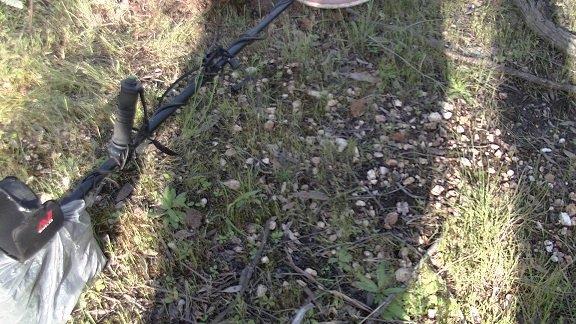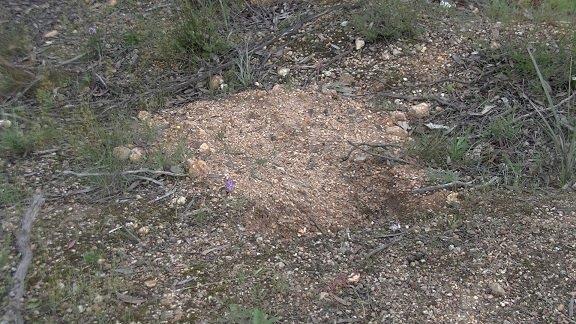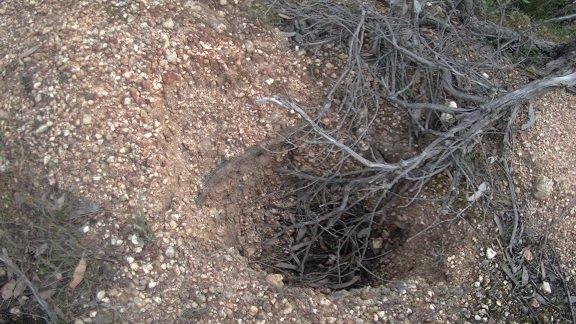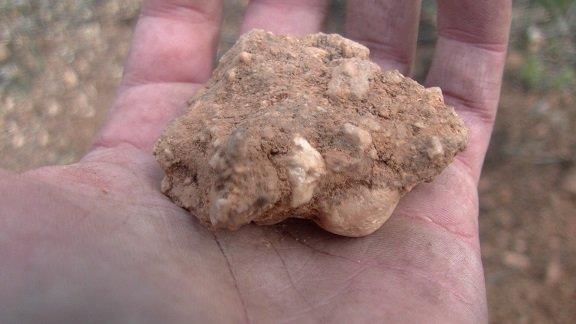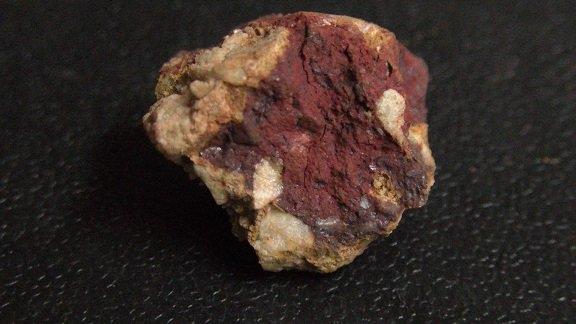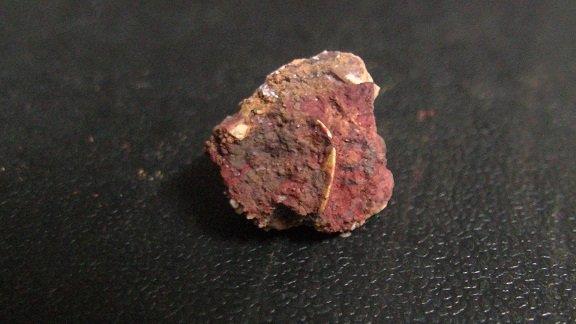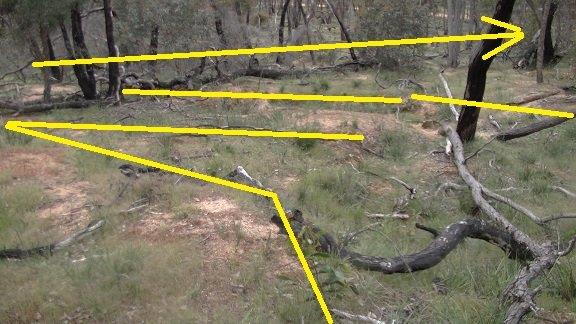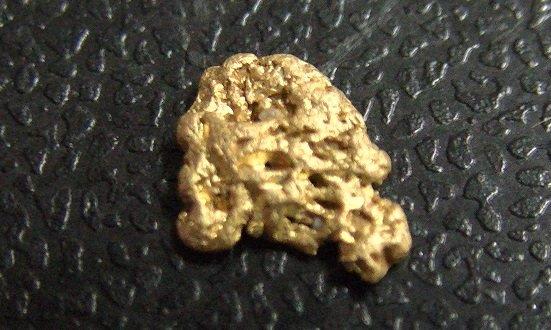Hi Dig'n-it,
Thanks for the post - I will post up some different rock types and minerals to help others see and hopefully can associate with their grounds - or at least have a better understanding.
The three main types, or classes, of rock are sedimentary, metamorphic, and igneous and the differences among them have to do with how they are formed.
SEDIMENTARY ROCKS
- Sedimentary rocks are formed from particles of sand, shells, pebbles, and other fragments of material or mineral. Together, all these particles are called sediment. [/*]
- This sediment can include minerals, small pieces of plants and other organic matter.[/*]
- The sediment is compressed over a long period of time before consolidating into solid layers of rock.[/*]
- Sedimentary rocks cover the majority of the Earth's rocky surface but only make up a small percentage of the Earths crust compared to metamorphic and igneous types of rocks.[/*]
- Examples of sedimentary rocks include limestone, sandstone, mudstone, chalk, coal, claystone and flint.[/*]
- Limestone forms the metamorphic rock marble when subjected to extreme heat and pressure over time (metamorphism).[/*]
- Sandstone forms the metamorphic rock quartzite.[/*]
- Mudstone forms the metamorphic rock slate.[/*]
- Chalk is a soft, white form of limestone.[/*]
- Sedimentary rocks forms layers called strata which can often be seen in exposed cliffs.[/*]

- Sandstone (sometimes known as arenite) is a clastic sedimentary rock composed mainly of sand-sized minerals or rock grains. Most sandstone is composed of quartz or feldspar because these are the most common minerals in the Earth's crust[/*]
- Breccia is a term most often used for clastic sedimentary rocks that are composed of large angular fragments (over two millimeters in diameter). The spaces between the large angular fragments can be filled with a matrix of smaller particles or a mineral cement that binds the rock together.[/*]
- Limestone is a sedimentary rock composed primarily of calcium carbonate (CaCO3) in the form of the mineral calcite. It most commonly forms in clear, warm, shallow marine waters. It is usually an organic sedimentary rock that forms from the accumulation of shell, coral, algal, and fecal debris. It can also be a chemical sedimentary rock formed by the precipitation of calcium carbonate from lake or ocean water.[/*]
- Conglomerate can have a variety of compositions. As a clastic sedimentary rock, it can contain clasts of any rock material or weathering product that is washed downstream or down current. The rounded clasts of conglomerate can be mineral particles such as quartz, or they can be sedimentary, metamorphic, or igneous rock fragments. The matrix that binds the large clasts together can be a mixture of sand, mud, and chemical cement.[/*]
- Shale is a fine-grained sedimentary rock that forms from the compaction of silt and clay-size mineral particles that we commonly call "mud." This composition places shale in a category of sedimentary rocks known as "mudstones." Shale is distinguished from other mudstones because it is fissile and laminated. "Laminated" means that the rock is made up of many thin layers. "Fissile" means that the rock readily splits into thin pieces along the laminations.[/*]
- Ironstone is a sedimentary rock, either deposited directly as a ferruginous sediment or created by chemical replacement, that contains a substantial proportion of an iron compound[/*]
METAMORPHIC ROCKS
Metamorphic rocks have been modified by heat, pressure, and chemical processes, usually while buried deep below Earth's surface. Exposure to these extreme conditions has altered the mineralogy, texture, and chemical composition of the rocks.
There are two basic types of metamorphic rocks. Foliated metamorphic rocks such as gneiss, phyllite, schist, and slate have a layered or banded appearance that is produced by exposure to heat and directed pressure.
Non-foliated metamorphic rocks such as hornfels, marble, quartzite, and novaculite do not have a layered or banded appearance.
- Metamorphic rocks have been changed over time by extreme pressure and heat.[/*]
- Metamorphic rocks can be formed by pressure deep under the Earth's surface, from the extreme heat caused by magma or by the intense collisions and friction of tectonic plates.[/*]
- Uplift and erosion help bring metamorphic rock to the Earth's surface.[/*]
- Examples of metamorphic rocks include anthracite, quartzite, marble, slate, granulite, gneiss and schist.[/*]
- Anthracite is a type of coal with a high carbon count, few impurities and with a high luster (meaning it looks shiny).[/*]
- Marble is a metamorphic rock that is formed from the sedimentary rock limestone.[/*]
- Quartzite is a metamorphic rock that is formed from the sedimentary rock sandstone.[/*]
- Slate is a metamorphic rock that is formed from the sedimentary rock mudstone.[/*]
- Granulite is a metamorphic rock that is formed from the igneous rock basalt.[/*]
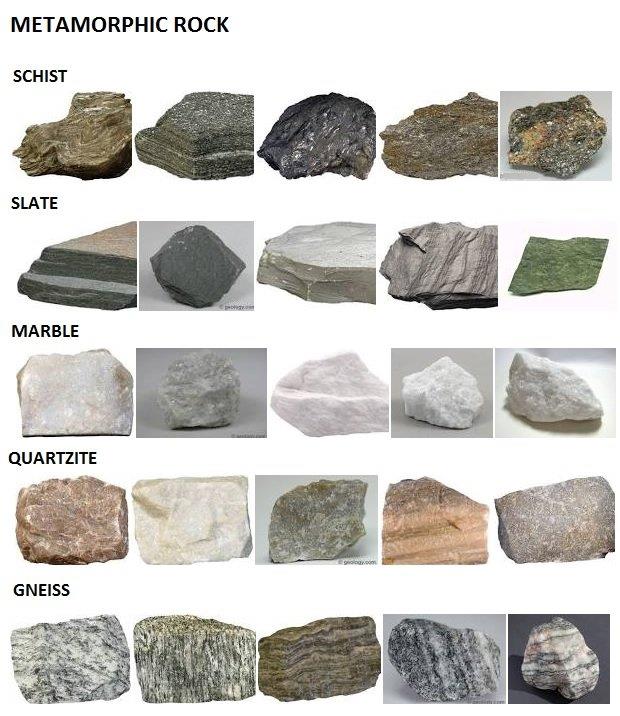
- Schist is a medium-grade metamorphic rock with medium to large, flat, sheet-like grains in a preferred orientation (nearby grains are roughly parallel). It is defined by having more than 50% platy and elongated minerals, often finely interleaved with quartz and feldspar.[/*]
- Slate is a fine-grained, foliated metamorphic rock that is created by the alteration of shale or mudstone by low-grade regional metamorphism. Slate is composed mainly of clay minerals or micas, depending upon the degree of metamorphism to which it has been subjected.[/*]
- Marble is a metamorphic rock that forms when limestone is subjected to the heat and pressure of metamorphism. It is composed primarily of the mineral calcite (CaCO3) and usually contains other minerals, such as clay minerals, micas, quartz, pyrite, iron oxides, and graphite.[/*]
- Quartzite is a nonfoliated metamorphic rock composed almost entirely of quartz. It forms when a quartz-rich sandstone is altered by the heat, pressure, and chemical activity of metamorphism. These conditions recrystallize the sand grains and the silica cement that binds them together. The result is a network of interlocking quartz grains of incredible strength.[/*]
- Gneiss is a foliated metamorphic rock identified by its bands and lenses of varying composition, while other bands contain granular minerals with an interlocking texture. Other bands contain platy or elongate minerals with evidence of preferred orientation. It is this banded appearance and texture - rather than composition - that define a gneiss. Gneiss can form in several different ways. The most common path begins with shale, which is a sedimentary rock. Regional metamorphism can transform shale into slate, then phyllite, then schist, and finally into gneiss.[/*]
IGNEOUS ROCKS
Igneous rocks are formed from the solidification of molten rock material. There are two basic types.
Intrusive igneous rocks crystallize below Earth's surface, and the slow cooling that occurs there allows large crystals to form. Examples of intrusive igneous rocks are diorite, gabbro, granite, pegmatite, and peridotite.
Extrusive igneous rocks erupt onto the surface, where they cool quickly to form small crystals. Some cool so quickly that they form an amorphous glass. These rocks include andesite, basalt, obsidian, pumice, rhyolite, scoria, and tuff.
- Igneous rock is formed when magma cools and solidifies, it may do this above or below the Earth's surface.[/*]
- Magma can be forced into rocks, blown out in volcanic explosions or forced to the surface as lava.[/*]
- The atoms and molecules of melted minerals are what make up magma.[/*]
- These atoms and molecule rearrange themselves into mineral grains as the magma cools, forming rock as the mineral grains grow together.[/*]
- There are over 700 different types of igneous rocks.[/*]
- Examples of igneous rocks include basalt, granite, pumice, obsidian, tuff, diorite, gabbro and andesite.[/*]
- Basalt forms the metamorphic rock granulite when subjected to extreme heat and pressure over time (metamorphism).[/*]
- Granite is a common rock that contains at least 25% quartz [/*]

- Basalt is a dark-colored, fine-grained, igneous rock composed mainly of plagioclase and pyroxene minerals. It most commonly forms as an extrusive rock, such as a lava flow, but can also form in small intrusive bodies, such as an igneous dike or a thin sill. It has a composition similar to gabbro. The difference between basalt and gabbro is that basalt is a fine-grained rock while gabbro is a coarse-grained rock.[/*]
- Gabbro is a coarse-grained, dark-colored, intrusive igneous rock. It is usually black or dark green in color and composed mainly of the minerals plagioclase and augite.[/*]
- Granite is a light-colored igneous rock with grains large enough to be visible with the unaided eye. It forms from the slow crystallization of magma below Earth's surface. Granite is composed mainly of quartz and feldspar with minor amounts of mica, amphiboles, and other minerals. This mineral composition usually gives granite a red, pink, gray, or white color with dark mineral grains visible throughout the rock. Granite is the best-known igneous rock. Many people recognize granite because it is the most common igneous rock found at Earth's surface[/*]
- Diorite is the name used for a group of coarse-grained igneous rocks with a composition between that of granite and basalt. Diorite is usually composed of sodium-rich plagioclase with lesser amounts of hornblende and biotite. It usually contains little if any quartz. This makes diorite a coarse-grained rock with a contrasting mix of black and white mineral grains. Some people often use this "salt and pepper" appearance as a clue to the identification of diorite.[/*]
MINERALS
Mineralogy is a subject of geology specializing in the scientific study of chemistry, crystal structure, and physical (including optical) properties of minerals and mineralized artifacts. Specific studies within mineralogy include the processes of mineral origin and formation, classification of minerals, their geographical distribution, as well as their utilization.
Minerals are not equivalent to rocks. A rock is either an aggregate of one or more minerals, or not composed of minerals at all. Rocks like limestone or quartzite are composed primarily of one mineralcalcite or aragonite in the case of limestone, and quartz in the latter case. Other rocks can be defined by relative abundances of key (essential) minerals; a granite is defined by proportions of quartz, alkali feldspar, and plagioclase feldspar. The other minerals in the rock are termed accessory, and do not greatly affect the bulk composition of the rock. Rocks can also be composed entirely of non-mineral material; coal is a sedimentary rock composed primarily of organically derived carbon.
In rocks, some mineral species and groups are much more abundant than others; these are termed the rock-forming minerals. The major examples of these are quartz, the feldspars, the micas, the amphiboles, the pyroxenes, the olivines, and calcite; except the last one, all of the minerals are silicates. Overall, around 150 minerals are considered particularly important, whether in terms of their abundance or aesthetic value in terms of collecting.

- Feldspar - an abundant rock-forming mineral typically occurring as colourless or pale-coloured crystals and consisting of aluminosilicates of potassium, sodium, and calcium. Typically off-white or shades of red, orange and brown, occasionally green.[/*]
- Quartz is the second most abundant mineral in Earth's continental crust, after feldspar. Pure quartz, traditionally called rock crystal or clear quartz, is colorless and transparent or translucent, and has often been used for hardstone carvings, such as the Lothair Crystal. Common colored varieties include citrine, rose quartz, amethyst, smoky quartz, milky quartz, and others.[/*]
- Magnetite is a mineral and one of the main iron ores. it is one of the oxides of iron. Magnetite is ferrimagnetic; it is attracted to a magnet and can be magnetized to become a permanent magnet itself. It is the most magnetic of all the naturally-occurring minerals on Earth. Naturally-magnetized pieces of magnetite, called lodestone, will attract small pieces of iron, which is how people first discovered the property of magnetism. Today it is mined as iron ore. Small grains of magnetite occur in almost all igneous and metamorphic rocks. Magnetite is black or brownish-black with a metallic luster.[/*]
- Arsenopyrite is an iron arsenic sulfide, It is a hard metallic, opaque, steel grey to silver white mineral with a relatively high specific gravity of 6.1. Arsenopyrite also can be associated with significant amounts of gold. Consequently, it serves as an indicator of gold bearing reefs. Many arsenopyrite gold ores are refractory, i.e. the gold is not easily liberated from the mineral matrix. Arsenopyrite is found in high temperature hydrothermal veins, in pegmatites, and in areas of contact metamorphism or metasomatism.[/*]
- Pyrite, or iron pyrite, also known as fool's gold, is an iron sulfide, This mineral's metallic luster and pale brass-yellow hue give it a superficial resemblance to gold, Pyrite is usually found associated with other sulfides or oxides in quartz veins, sedimentary rock, and metamorphic rock, as well as in coal beds and as a replacement mineral in fossils. Despite being nicknamed fool's gold, pyrite is sometimes found in association with small quantities of gold. Gold and arsenic occur as a coupled substitution in the pyrite structure. In the Carlintype gold deposits, arsenian pyrite contains up to 0.37 wt% gold. [/*]
- Chalcopyrite is a brass-yellow mineral. It occurs in most sulfide mineral deposits throughout the world and has been the most important ore of copper for thousands of years. The surface of chalcopyrite loses its metallic luster and brass-yellow color upon weathering. It tarnishes to a dull, gray-green color, but in the presence of acids the tarnish can develop a red to blue to purple iridescence.[/*]
- Sphalerite is a mineral that is the chief ore of zinc. It consists largely of zinc sulfide in crystalline form but almost always contains variable iron. When iron content is high it is an opaque black variety, marmatite. It is usually found in association with galena, pyrite, and other sulfides along with calcite, dolomite, and fluorite. Miners have also been known to refer to sphalerite as zinc blende, black-jack, and ruby jack.[/*]
- Galena, also called lead glance, is the natural mineral form of lead sulfide. It is the most important ore of lead and an important source of silver.[/*]
- Silver - The metal is found in the Earth's crust in the pure, free elemental form ("native silver"), as an alloy with gold and other metals, and in minerals such as argentite and chlorargyrite. Most silver is produced as a byproduct of copper, gold, lead, and zinc refining[/*]
Hopefully this shows some rock types for those who need a basic understanding, knowing the mineral associating the rock to the three main types. Many of us dont have a degree in geology chemistry physics mineralogy - but we have access to a large amount of literature and this can increase our knowledge considerably.
I hope you all enjoy the post - I tried to not make this a complicated explanation - but more so summarize the best I could.




